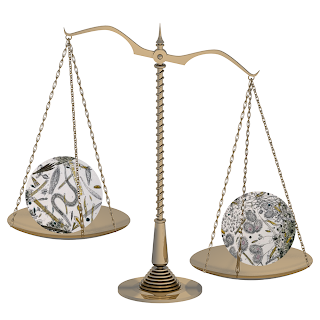Readers will perhaps recall that in the last post, I explained that the application of fertilizers and mechanized agriculture have vastly expanded human populations... well, I didn't say that specifically, but we all know it's true. The sheer number of human beings on the planet has exploded; and the balances and population levels of countless different organisms have consequentially suffered or benefited.
One of the well-known situations in ecological analysis of the biosphere is that species maintain balances relative to one another — that is to say, they are not exactly "balanced," but the density of various species is directly related. If one species becomes more dense, another one become will be less so, and so on. There are winners and losers not only in the primary species, but in all of their accessory companions.
Dependencies change. One of the recent cover articles in Scientific American (see King of Beasts, in the November 2013 issue) explains that it's quite likely that the rise of human predators on the great plains of Africa led to a notable reduction in the diversity of carnivores who competed with them.
What I suspect is true — although I don't have any proof for it — is that the expansion of human population has had, and is having, similar impacts on the microbial world. That is to say, microbes exist in specific balances with one another and with the macroscopic species that they interact with. Drastic changes in the macro environment that affect microbes will ultimately have effects similar to the ones hypothesized by Lars Werdelin.
For example, wherever there are a lot more human beings, there's a proliferation of the specific bacterial species associated with human activity. This is self-evident. A second self-evident consequence is that these bacteria compete with other bacteria; and since, even on the bacterial scale, resources are limited, if bacteria and other microbes associated with human activity get a leg up because of all the humans they have to interact with and colonize, they are able to reproduce and spread at the expense of other bacterial species that would find other, different conditions more favorable.
This may not seem like it means a lot; but it what it means is that environmental holocausts, in which huge populations of important species are eventually lost (again, see Werdelin's article), can take place on the microbial as well as the macroscopic scale. The microsphere functions in essentially the same way the macrosphere does; and our manipulation of the environment may have the result of completely overwhelming important microbiological communities we haven't studied or looked at. This can lead to a wide range of malaises that affect the health of species such as, for example, bees.
Let's think about that one for a minute. It's well-known that bee populations have been collapsing all over the world. Everyone assumes that this must be because of either a pesticide, a group of pesticides, a pathogen (infectious disease, whether viral or bacterial) or a new kind of parasite — although they haven't been able to identify any special new parasites, just lots of the old ones in weak hives. But what if it has something to do not with what the bees have — that is, pesticide or disease affecting them — but with something they don't have? What if we have inadvertently wiped out bacterial species that they need for their survival, which now can't populate their bodies and their hives properly? This "subtractive effect" — whereby a missing microbe is what causes weakness in a population — is much more difficult to measure, but it almost certainly exists.
I haven't seen much discussion of this particular issue in scientific journals, but it strikes me that biologists ought to take a closer look at it.

No comments:
Post a Comment
Note: Only a member of this blog may post a comment.